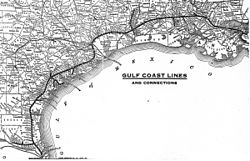St. Louis, Brownsville and Mexico Railway
 |
|

Gulf Coast Lines system map, circa 1920
|
|
| Reporting mark | StLB&M, SLBM, SBM |
|---|---|
| Locale | Texas |
| Dates of operation | 6 June 1903–1 March 1956 |
| Successor | Missouri Pacific |
| Track gauge | 4 ft 8 1⁄2 in (1,435 mm) standard gauge |
| Headquarters | Kingsville, Texas |
Chartered on June 6, 1903, the St. Louis, Brownsville & Mexico Railway (also known as the Brownie) was a 200-mile (321 km) railroad that operated from Brownsville, Texas to Gulf Coast Junction in Houston, Texas. It served numerous towns and cities along its routes and operated a rail bridge south of Laredo, Texas, in junction with the Mexican government. The Brownie connected the citizens of Brownsville to nearby Corpus Christi for the first time on land rather than using water transportation.
After Uriah Lott's success with his first railroad project, the Corpus Christi, San Diego and Rio Grande Narrow Gauge Railroad in March 1875, he envisioned a plan of creating land transportation along the southern interior of Texas. Uriah collaborated with business partner Benjamin Franklin Yoakum to create a large rail system that reached from Chicago, Illinois, in the north and Mexico City, Mexico, to the south. To put this plan into effect, Yoakum used control from one of his two railroads he was president from - the St. Louis - San Francisco - to create several railroads within Texas and Louisiana as a system. Known as the Gulf Coast Lines, the system was created in three phases under three different railroads: The St. Louis, Brownsville and Mexico (Phase 1 - June 1903), the Beaumont, Sour Lake & Western (Phase 2 - October 1903) and the New Orleans, Texas & Mexico Railway (Phase 3 - September 1909).
In April 1904, the St. Louis, Brownsville & Mexico took delivery of their first three new locomotives: Burnham, Williams & Co. 4-4-0s #925, 926 & 927. Shortly after the arrival of the locomotives, the first segment of track was completed on July 4, 1904, which reached Brownsville, Texas, from its starting point in Robstown, Texas. On December 31, 1907, the second (and last) major segment of track on the Brownie was completed to Houston from its starting point in Robstown and reaching Sinton as well.
...
Wikipedia
